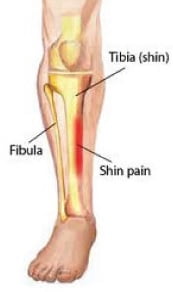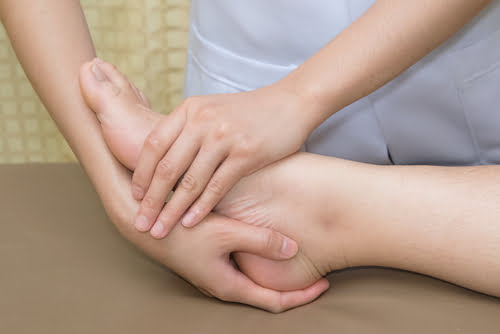Shin Splints – Why do my shins hurt when I run?
 Have you experienced pain on one or both of your shins when you run? You are not alone! At Align Body Clinic we have helped dozens of runners get over their shin pain, enabling them to carry on running and achieve their fitness goals. Shin pain is a reasonably common lower leg problem, mostly suffered by people who engage in high impact repetitive activities such as running, dancing, gymnastics, football or basketball.
Have you experienced pain on one or both of your shins when you run? You are not alone! At Align Body Clinic we have helped dozens of runners get over their shin pain, enabling them to carry on running and achieve their fitness goals. Shin pain is a reasonably common lower leg problem, mostly suffered by people who engage in high impact repetitive activities such as running, dancing, gymnastics, football or basketball.
The term ‘shin splints’ is a catch-all term that refers to all exercise-induced shin pain, of which two are most commonly experienced by runners or active people, these are,
- Medial tibial traction periostitis (pain on the inside of the shin)
- Anterior compartment syndrome (or exercise-induced compartment syndrome) (1). (pain travelling vertically down the outside of the shin)
Medial Tibial Traction Periostitis
This is a condition where people experience pain on the inside (medial) of the lower portion of their shin bone (tibia) when they place their weight on the foot. At first the pain may be vague and only felt while the person is beginning to exercise and afterwards, but as it progresses it can be painful during exercise causing the person to stop their activity (2).
What causes it? – Several muscles including the soleus and the plantar flexors attach to the inside of the tibia, when the foot hits the ground during running or walking these muscles contract to ‘dampen’ the impact and help reduce rotational movement of the tibia (3). The muscles attach to a fibrous coating around the bone called the periosteum, over time if the muscles that are affected are over-stressed then their attachment begins to ‘pull’ at the periosteum causing inflammation and pain (4). So what would be considered ‘over-stressing of the muscles of the medial shin?
Biomechanical factors – Usually this means that the hip, knee, leg or ankle joints are not performing properly due to either muscle imbalances in the pelvis, thigh or lower leg. Common findings are a foot that overpronates (the inside edge drops towards the ground on weight-bearing), or the knee goes into a valgus pattern (falls inwards when bending the knee while standing on one leg). Both of these patterns cause the tibia to rotate placing excessive stress on the muscles and the periosteum, resulting in pain. (1, 4).
Equipment and training patterns – Often people are wearing the wrong type of shoes for their activity, if the shoes are excessively worn (losing shock absorption) then this can also be a problem. Commonly the problem is that sufferers have increased their activity levels too soon, they are either running too far, too fast or on surfaces that are too challenging (hills, trails etc) (5).
Note – this condition can commonly be misdiagnosed as a stress fracture of the tibia, which also occurs in runners and other athletes, differentiating between the two requires careful assessment by a qualified professional (1).
%27%20fill-opacity%3D%27.5%27%3E%3Cellipse%20fill%3D%22%23cca9b5%22%20fill-opacity%3D%22.5%22%20rx%3D%221%22%20ry%3D%221%22%20transform%3D%22matrix(-21.64712%20-4.43455%2028.69846%20-140.09068%2083.5%20110.2)%22%2F%3E%3Cellipse%20fill%3D%22%23fff%22%20fill-opacity%3D%22.5%22%20rx%3D%221%22%20ry%3D%221%22%20transform%3D%22matrix(-35.91297%20-3.71124%2014.69933%20-142.2425%2025.1%2063.3)%22%2F%3E%3Cellipse%20fill%3D%22%23fff%22%20fill-opacity%3D%22.5%22%20rx%3D%221%22%20ry%3D%221%22%20transform%3D%22matrix(17.677%20-139.92783%2023.02714%202.909%20132.1%20133.9)%22%2F%3E%3Cellipse%20fill%3D%22%23aabab5%22%20fill-opacity%3D%22.5%22%20rx%3D%221%22%20ry%3D%221%22%20transform%3D%22matrix(34.419%20-65.53066%2010.23705%205.37686%2060.9%20184.8)%22%2F%3E%3C%2Fg%3E%3C%2Fsvg%3E) Anterior compartment syndrome/or exercise-induced compartment syndrome
Anterior compartment syndrome/or exercise-induced compartment syndrome
Usually this condition is felt in the front (anterior) section of the shin down onto the top of the foot. The muscles that are most commonly affected are the tibialis anterior and the extensors of the foot, they contract to pull the foot up towards the knee, or to limit excessive movement of the knee over the foot when walking or running (Leva). The pain is usually felt along the muscle in a vertical pattern along the outside of the front of the shin and onto the top of the foot. It is described as being burning, or cramping, and mainly felt at the beginning of exercise when mild, but can get worse with consistent activity such as running or walking (1).
What causes it? – Muscles, and muscle groups are divided into compartments, each compartment is surrounded by a tough fibrous layer that allows a limited degree of stretch. When a person exercises it causes an increase in tissue pressure in each compartment, this leads to a ‘constriction’ and a reduction of the blood supply to the muscle which the body communicates as pain. Once a person stope exercising the pressure reduces, the blood can once again supply the muscle and the pain goes away, only to return on exercise again. Over time the fibrous layer surrounding the muscle may get thicker and less elastic which compounds the problem.
Often the reasons for anterior compartment syndrome are similar to the medial tibial version of shin splints, faulty biomechanics or improper training progressions. Commonly it is seen in runners (often beginners) who increase the distance they are running too quickly resulting in the tibialis anterior muscle growing too quickly for its fibrous compartment (1, 4, 5).
%22%20transform%3D%22translate(.6%20.6)%20scale(1.27344)%22%20fill-opacity%3D%22.5%22%3E%3Cpath%20fill%3D%22%237c6516%22%20d%3D%22M-4%2076.8l213.6%2090.6-35.6%2083.8-213.6-90.6z%22%2F%3E%3Cellipse%20fill%3D%22%23d9d4e1%22%20cx%3D%22117%22%20cy%3D%222%22%20rx%3D%2277%22%20ry%3D%2290%22%2F%3E%3Cellipse%20fill%3D%22%23e37598%22%20rx%3D%221%22%20ry%3D%221%22%20transform%3D%22matrix(-77.8113%20-41.32482%2016.80394%20-31.64046%20115.4%20104.6)%22%2F%3E%3Cellipse%20fill%3D%22%2399aab9%22%20rx%3D%221%22%20ry%3D%221%22%20transform%3D%22matrix(74.65425%207.97781%20-7.1563%2066.96678%20228.2%2066.3)%22%2F%3E%3C%2Fg%3E%3C%2Fsvg%3E) What can I do if I think I have shin splints?
What can I do if I think I have shin splints?
The best immediate action to take is to reduce the activity that is causing the pain to see if it recedes. As a rule of thumb, reducing activity by 50% for a period of between 2-6 weeks can often dramatically reduce the symptoms (1). Alongside this it is crucial to get a thorough assessment and diagnosis of what caused the problem in the first place. This should include an assessment of a person’s biomechanics (joint motion and muscle strength) and a thorough review of their training plan and equipment.
How do I get rid of the pain and get back to exercise?
The pain from shin splints is commonly treated with manual therapy, including deep tissue massage, joint mobilisation and acupuncture (1, 4). The real benefit is found in correcting the biomechanics and movement issues that have led the affected tissues to become painful, this can be achieved by modifying a person’s training plan and careful prescription of exercise to address the underlying problem. This is especially true in the case of MTSS, as weakness in the muscles of the trunk and thigh can lead to excess strain on the lower limb resulting in pain. If these measures are not successful then medical imaging may be necessary to gain more information (6). At Align Body Clinic we can perform a thorough investigation of your shin pain, conduct a full assessment, and then advise on the best solution to help get you back on the road!
If an injury has stopped you from running or pain has stopped you from achieving your running goals? If so why not book a running injury consultation with our expert osteopath Jay Ruddock.
References
1 – Carnes, M, & Vizniak, N. (2011). Conditions Manual. Professional Health Systems, Canada.
2 – Wheeless’ Textbook of Orthopaedics. Shin Splints / Medial Tibial Stress Syndrome. Available at: http://www.wheelessonline.com/orth/shin_splints_medial_tibial_stress_syndromefckLR].
3 – Levangie, P. and Norkin, C. (2005) Joint Structure and Function: A Comprehensive Analysis (4th ed). F. A. Davis, Philadelphia.
4 – Brukner, P. and Khan, K. (2007). Clinical Sports Medicine (3rd Ed). McGraw Hill, Sydney.
5 – Galbraith RM, Lavalee ME (2009). ‘Medial Tibial Stress Syndrome: Conservative Treatment Options’, Current Reviews in Musculoskeletal Medicine, 2(3), pp. 127-133.
6 – Broos P (1991). Sportletsels : aan het locomotorisch apparaat. Leuven: Garant, pp. 179-181.



 Anterior compartment syndrome/or exercise-induced compartment syndrome
Anterior compartment syndrome/or exercise-induced compartment syndrome What can I do if I think I have shin splints?
What can I do if I think I have shin splints?